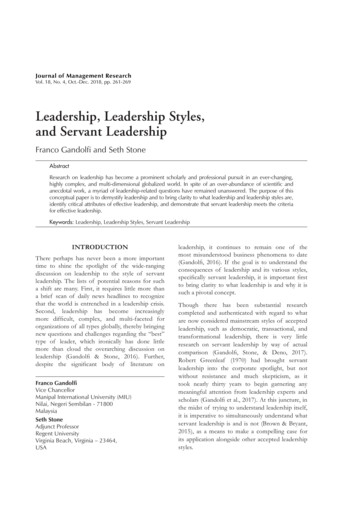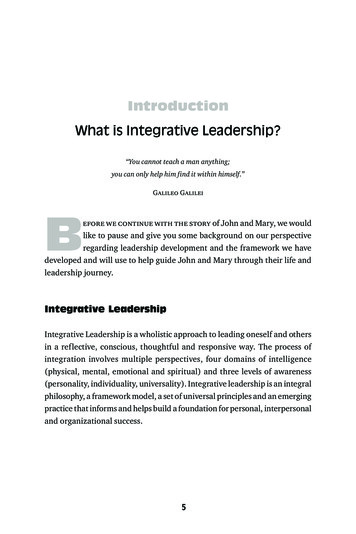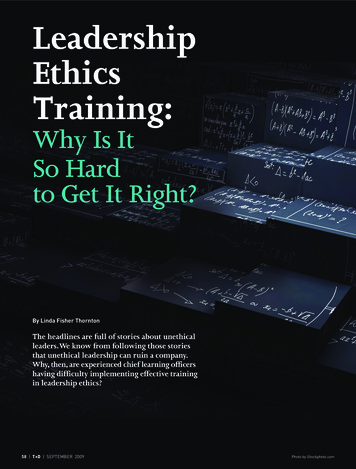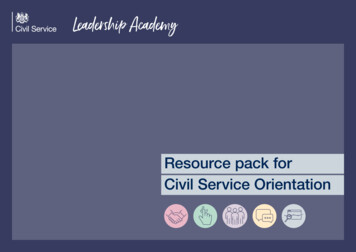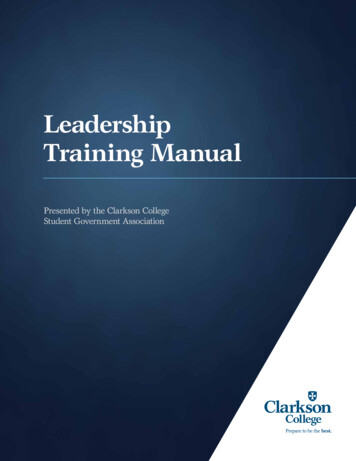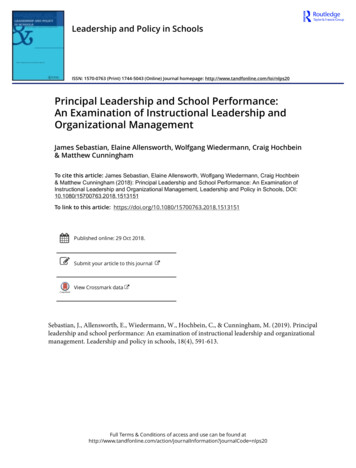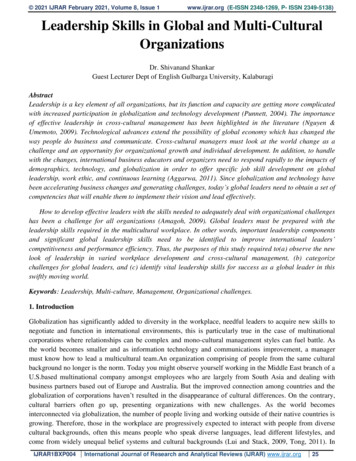
Transcription
2021 IJRAR February 2021, Volume 8, Issue 1www.ijrar.org (E-ISSN 2348-1269, P- ISSN 2349-5138)Leadership Skills in Global and Multi-CulturalOrganizationsDr. Shivanand ShankarGuest Lecturer Dept of English Gulbarga University, KalaburagiAbstractLeadership is a key element of all organizations, but its function and capacity are getting more complicatedwith increased participation in globalization and technology development (Punnett, 2004). The importanceof effective leadership in cross-cultural management has been highlighted in the literature (Nguyen &Umemoto, 2009). Technological advances extend the possibility of global economy which has changed theway people do business and communicate. Cross-cultural managers must look at the world change as achallenge and an opportunity for organizational growth and individual development. In addition, to handlewith the changes, international business educators and organizers need to respond rapidly to the impacts ofdemographics, technology, and globalization in order to offer specific job skill development on globalleadership, work ethic, and continuous learning (Aggarwa, 2011). Since globalization and technology havebeen accelerating business changes and generating challenges, today’s global leaders need to obtain a set ofcompetencies that will enable them to implement their vision and lead effectively.How to develop effective leaders with the skills needed to adequately deal with organizational challengeshas been a challenge for all organizations (Amagoh, 2009). Global leaders must be prepared with theleadership skills required in the multicultural workplace. In other words, important leadership componentsand significant global leadership skills need to be identified to improve international leaders’competitiveness and performance efficiency. Thus, the purposes of this study required to(a) observe the newlook of leadership in varied workplace development and cross-cultural management, (b) categorizechallenges for global leaders, and (c) identify vital leadership skills for success as a global leader in thisswiftly moving world.Keywords: Leadership, Multi-culture, Management, Organizational challenges.1. IntroductionGlobalization has significantly added to diversity in the workplace, needful leaders to acquire new skills tonegotiate and function in international environments, this is particularly true in the case of multinationalcorporations where relationships can be complex and mono-cultural management styles can fuel battle. Asthe world becomes smaller and as information technology and communications improvement, a managermust know how to lead a multicultural team.An organization comprising of people from the same culturalbackground no longer is the norm. Today you might observe yourself working in the Middle East branch of aU.S.based multinational company amongst employees who are largely from South Asia and dealing withbusiness partners based out of Europe and Australia. But the improved connection among countries and theglobalization of corporations haven’t resulted in the disappearance of cultural differences. On the contrary,cultural barriers often go up, presenting organizations with new challenges. As the world becomesinterconnected via globalization, the number of people living and working outside of their native countries isgrowing. Therefore, those in the workplace are progressively expected to interact with people from diversecultural backgrounds, often this means people who speak diverse languages, lead different lifestyles, andcome from widely unequal belief systems and cultural backgrounds (Lui and Stack, 2009, Tong, 2011). InIJRAR1BXP004International Journal of Research and Analytical Reviews (IJRAR) www.ijrar.org25
2021 IJRAR February 2021, Volume 8, Issue 1www.ijrar.org (E-ISSN 2348-1269, P- ISSN 2349-5138)addition, this phenomenon of globalization, not only challenges, but also transforms through intellectualalteration, roles and behaviorsshowed by leaders (Vaccaro, et al., 2010).2. Definitions:Leadership is the ability to influence others by setting and inspiring example. The example is one thatmotivates people to pursue goals that benefit the organization. Naturally, leadership involves producing avision of the organizational future, planning a strategy for attaining that vision, and communicating thatvision to all members of the organization.Dave Strathmann (USA) has defined “A good multicultural leader demonstrates excellence in skillsincluding listening, patience, respect, and helpfulness while remaining courteous. A multicultural leader willshow respect for as well as make accommodations to allow individuals of different cultures to interact andcontribute comfortably with those of different cultures and beliefs.”Naresh Purushotham (India) has defined “Multicultural leadership is leading a global workforce withdistributed teams from across the world having team members drawn from different countries, cultures,languages, religious beliefs, and ethnicity. Great multicultural leadership requires flat organizationalstructures.”3. Review of LiteratureA successful international leader must know what leadership is anticipated and execute it accordingly (Ulrich& Smallwood, 2012). Individuals with different cultural backgrounds may vary in their conception andpotentials of leadership. Due to the largely Western and individualistic perspective on leadership, the rangeto which Western leadership theories apply globally is being questioned. Japanese leadership practice, forexample, is different from the West by its cultural traditions and business practices (Takahashi, Ishikawa &Kanai, 2012). To create a leadership that lasts over time, global leaders must show expected competence incross-cultural awareness and practice. It is important they recognize the significance of leadership andleadership expectations, and to develop and sustain effective leadership strategies for long-term change(Ulrich & Smallwood, 2012).Effective global leadership is a key to unlock the unknown of working with diverse employees and bring theorganizational development and change to the next level. Multicultural teams are defined as teams consistingof “individuals from different cultures working together on activities that extent national borders” (Snell,Snow, Davidson, & Hambrick, 1998, p. 147). Two important aspects of global multicultural teams are thatthey are culturally diverse and geographically dispersed, and their members typically communicate virtuallywith each other (Stanko & Gibson, 2009). Therefore, the global multicultural team environment differs inmany aspects from that of co-located culturally homogeneous teams and thus represents a complex anddynamic environment (Gibson & Gibbs, 2006).3.1. Emerging a Universal Leadership ModelMorrison (2000) arguments out that global leadership models must draw from many academic disciplines tobe able to understand and appreciate the business environment across the world. By using a multidisciplinary approach, leaders can understand the communities where the organization is existing and havethe ability to work with and motivate people in the different cultures. The model also points out that domesticleadership models that work in a particular country will not always work in the global environment. Withinthe United States, the concept of long-term efficiencies is common in leadership.IJRAR1BXP004International Journal of Research and Analytical Reviews (IJRAR) www.ijrar.org26
2021 IJRAR February 2021, Volume 8, Issue 1www.ijrar.org (E-ISSN 2348-1269, P- ISSN 2349-5138)Tubbs and Schultz (2006) make the point that there is nothing more important than to define and describe thecompetencies that makeup leadership within global organization. These competencies need to be defined anddefined so that organizations can confirm they are trained throughout the organization so as to help achievethe strategic goals that move the organization forward within the industrial subdivision. The self-confidenceof the leader is something that is dominant in the area of personality that must be taken into account when itcomes to leadership competencies.3.2. Global Leadership CompetenciesJokinen (2005) discusses Competencies have been defined in the past as moreover behavioral, personality,values and knowledge as the outline to teach and study the core global leadership competencies. Heexplained that how by increasing the understanding of globalization and the interrelatedness that attends thatinterconnectedness allows leaders to be able to change the organization to meet any challenges theorganization may encounter. The competencies that should be taught and instructed within the organizationmust be directly related to their global business strategy. The organization needs to have a framework withinwhich to look at the organizational strategy, so the competencies can be taught throughout the organization.Without a meta-framework, any organization will not have the ability to coherently analyze the strategies andthen place the learning in the context of a holistic system for teaching.Competencies have been defined in the past as either behavioral, personality, values and knowledge as theframework to teach and study the core global leadership competencies Jokinen (2005) identifies three areasof core global leadership competencies that must be addressed and studied i.e. behavioral, cognitive, and corecompetencies. Jokinen suggests the core competencies of self-awareness, inquisitiveness, and personaltransformation as the driving factors in the study and practice of global leadership. The core competencies allstress the importance of continuous learning the application of the knowledge that was learned. These corecompetencies are viewed as the forces that move the other two competency areas of behavior and cognitive.3.3. Leadership in Various WorkplacesOkoro, (2012) explained a sustainable advantage of globalization depends on the skills and abilities of aleader who can manage diversity and implement increasingly complex business strategies. Effectiveworkforce diversity management is a key to global business success In search of leadership effectiveness intoday’s globalized world, cross-cultural leaders need to be able to achieve culturally diverse settingsefficiently, known as a capability of cultural intelligence or cultural quotient CQ (Rockstuhl et al., 2011).Since CQ is significantly related to individual international experiences (Lovvorn& Chen, 2011), globalleaders should be aware and appreciate the diversity they face in leadership practices. The followingphenomena are identified significantly challenging international leadership practices in diverse workplaces.3.4. Group DynamicGroup dynamic plays an influential role in global leadership practice. Different leadership styles andmanagement approaches must be applied depending upon group dynamics and circumstances (Punnett,2004). A critique or judgment can significantly affect individuals’ behavior and values when the environmentis shaped by the same group pattern or thought. In many cases, leadership is often influenced by theperceptions of the peers, subordinates, and superiors (Heller, 1982). A number of group dynamic processesof norms, roles, relations, and behaviors are normally created to separate group members from others. Eachof these group dynamics plays an important role in shaping the global leadership with a strong impact onorganizational culture and climate. Group dynamic is the key for cultural innovation (Ragir& Brooks, 2012).However, team size can affect group dynamic, as well as leadership. For instance, a formal or autocraticIJRAR1BXP004International Journal of Research and Analytical Reviews (IJRAR) www.ijrar.org27
2021 IJRAR February 2021, Volume 8, Issue 1www.ijrar.org (E-ISSN 2348-1269, P- ISSN 2349-5138)leadership is needed for direction when the group size is large (Lussier, 2005). Dynamic cross-culturalcompetencies are accordingly vital to global leaders and managers, which can be enhanced by personalitycharacteristics and cross-cultural experiences development (Caligiuri &Tarique, 20123.5. Diversity in CultureOne important variable that should be considered in leadership is cultural context (Gutierrez, Spencer & Zhu,2012). Work ethics, behaviors, communication styles, and management-labor relationships are different fromcountry to country. Leadership competence is conceptualized differently in different countries (Kowske &Anthony, 2007). In high context countries like Japan, China, and South Korea employees tend to preferindirect messages and trust heavily on nonverbal codes; though, employees from low context countries (e.g.,Germany and Great Britain) tend to communicate directly and paradigm more information in messages(Hackman & Johnson, 2004). In accordance with different cultural expectations, different cultural groupshave different expectations of leadership, and this can affect the behaviors of employees and managers. It iscritical that employees are aware of their leaders’ appreciation for individual cultural differences withoutpersonal bias (Nguyen & Umemoto, 2009). Since cooperative relationships are often observed in Asiacountries, most of the Asians tend to feel individual praising will influence group harmony, and the managershould praise the entire group rather than one specific group member (Lussier, 2005). By doing so, theleaders can better achieve their responsibilities of making a multi-cultural workplace and a strategic foresightof organizational innovation.3.6. Gender DifferencesMorosini, (2005) explained genders are two different species in terms of genetics, psychology, and workrelated management. Females tend to hear what and how it is being said and display greater levels of interestin interpersonal relations; in contrast, males tend to hear only what has been said and display greater levels ofaggression (Morosini, 2005). Men are usually expected to be an destructive and tough leader while womenare characterized as emotional and unconfident followers with the need of protection. Women tend to havedifferent qualities in their working styles, and such differences can underwrite to necessary behavior, thoughtand leadership; though, gender bias has interfered in obtaining their leadership positions (Ely, Ibarra & Kolb,2011; Vinnicombe & Singh, 2003).To solve this problem, developing a women-only leadership program has been proposed and used to assistwomen leaders toward senior leadership roles. For example, a national New Zealand Women in LeadershipProgram has operated for five years, and the program has been a success on individual and organizationallevels to increase participants’ self-confidence, networking skill, and opportunity for job promotion (Harris& Leberman, 2012). As the number of working women continually increases, understanding genderstereotype can assist multicultural leaders to build positive relationships and avoid biased managementdecisions (Carr-Ruffino, 2005).3.7. Women as LeadersResearch indicates that men’s attitudes toward women in the workplace are gradually changing as morewomen enter the workforce and assume leadership positions within global organizations. The number ofwomen in leadership positions has increased steadily since 1970. Women occupy slightly over 25 percent ofthe supervisory position in U.S. industry and just 11 percent of senior executive positions, although theyrepresent 51 percent of the world population (Sellers, 1999). Studies show, however, that both men andwomen executives believe women have to be exceptional to succeed in the business world. Women leadersstill face disadvantages in business and feel they must work tougher than men to succeed (Rosener, 1990). InIJRAR1BXP004International Journal of Research and Analytical Reviews (IJRAR) www.ijrar.org28
2021 IJRAR February 2021, Volume 8, Issue 1www.ijrar.org (E-ISSN 2348-1269, P- ISSN 2349-5138)the past, successful leaders have been related with conventional masculine attributes such as competitiveness,task orientation, and willingness to take risks. However, a trend exists of more women making their way tothe top who are not only accepting styles and attitudes they have developed from their experiences as women(Parry, 2000). Generally, women are more likely to use behaviors that are associated with transformationalleadership, such as reliance on expertise, charisma, and interpersonal skills. Men, on the other hand are morelikely to be instruction in their approach to leadership within the organization (Parry).Recent studies,however, show that female middle and top-level executives no longer equate successful leadership with thesemasculine attributes. Experienced female managers demonstration no differences in leadership ability fromtheir experienced male counterparts. Both groups possess a high need for accomplishment and power, andboth demonstrate forcefulness, self-reliance, risk taking, and other traits and behaviors associated withleadership. Once men and women have established themselves as leaders in organizations, women do notbehave differently than men (Powell, 1990).4. Challenges for Global LeadersA quite flexible relationship between global leaders and their followers is vital in the workplace.Globalization, technologic innovation, demographic changes bring a tremendous transformation into humanlife and work. For organizations to remain competitive in the global market, a close emotional codependentlink and an ongoing development of trust and loyalty between leaders and followers must be established. Agreater manager-employee relationship can significantly influence members’ behaviors and increase thedegree of their commitment to the leader and the organization (Lussier, 2005). The relationship can beenhanced by spending time together and considering the members’ needs, expectations, and values. Globalleaders cannot have an outstanding performance without the capability to guide and influence employees towork toward the organizational goals.Technology plays a important role in global policies, economics, and culture and shapes the structure of theglobal system (Fritsch, 2011). Technological improvement has not only saved time and money for a greaterorganizational profit and a better quality of life but has also created a global village with shared regulation,language, and values. The business and the nature of work are changed by technology (Aggarwa, 2011). Itmakes distance learning and timework happen. Online learning is a normally used training strategy, and bothweb meeting and e-mail are must-have tools for organizational communication. Virtual workforce, virtualorganizations, and leadership are also developing from technology development. Different leading tactics arethus compulsory in the new virtual working environment (Wang, 2011).5. Important Leadership Skills to become a successful Global LeaderSuccessful leaders are the influence and intellect behind their organizations. They are the visionaries chargedwith routing their brand around pitfalls. They must know when to seize opportunities and how to conventionemployees to work hard toward their company’s goals. Seeding high-potential talent, selecting topperformers for development and stretch assignments, and securing a future for them at the company beyondtheir own borders signals to those at headquarters that you are thinking and acting like a global leader. Globalleaders should understand globalization has differing effects on countries and people (Swanson & Holton,2009). Since global leaders’ job purposes and responsibilities are more compound and difficult than before, afuture-oriented and flexible leadership style is compulsory. Organizations need specific leadershipdevelopment approaches for effective leadership and organizational presentation (Amagoh, 2009). To keeppace with the rapidly changing environment, leaders need more interpersonal skills to meet current and futurechallenges.IJRAR1BXP004International Journal of Research and Analytical Reviews (IJRAR) www.ijrar.org29
2021 IJRAR February 2021, Volume 8, Issue 1www.ijrar.org (E-ISSN 2348-1269, P- ISSN 2349-5138)The following are important leadership skills that global leaders should own:5.1. Encourages and motivates others - Great leaders create a vision of the future that is vivid andcompelling, and that motivates employees to want to achieve it. Everyone wants to work for a company thatmakes a difference in the world. As a leader, you are best able to help the members of your team connectwhat they do to the impact it has on customers and communities.5.2. Shows high honesty and morality - Great leaders are honest and clear and have high morality they dowhat they say they are going to do, and they walk their talk. As Umpqua Bank CEO Ray Davis said in hisbook Leading Through Uncertainty, "I always tell our people that they're entitled to get answers to everyquestion they have.5.3. Initiatives for results - Some people are happy to sit back and watch the world go by, while othersaren't unless they are making things happen in their organizations. Great leaders have a advanced level ofdetermination, stick-to-itiveness, and drive than most anyone else, and they can be tallied on to get thingsdone.5.4. Resolves problems and examines issues - Eventually, leaders are recruited, trained, and chosen to solveorganizational problems, and to take advantage of opportunities in the marketplace. This involves not onlyexcellent logical abilities, but also above average people skills.5.5. Communicates strongly and productively -Great leaders communicate with their people frequently,and in a diversity of different ways. Whether it's by means of one-on-one conversations, team meetings, blogposts, email messages, phone or Skype calls, or any other such medium, leaders don't talk aboutcommunicating they just do it.5.6. Demonstrate technical or professional expertise -Utmost leaders start out in business with a specificskill, such as selling, or accounting, or designing software. The best leaders build on their technical andprofessional skills over time, becoming appreciated experts in their field and skilled at leading their team.5.7. Builds strong relationships -Business is built on a compacted foundation of relationships and faith.Without these two things, you can't have a business, or at least not a successful business. Leader should taketime every day to build relationships with the members of the team, customers and vendors. The strongeryour relationships, the better a leader you will be.5.8. Displays a strategic outlook -Great leaders have a long-term vision of the future, and they avoidattainment bogged down in the here and now. While they can be tactical when necessary, they maintain thestrategic outlook necessary to guide their businesses to the best future possible.5.9. Innovates -"innovation is the main lever to create a more competitive economy." The ability to innovateis a key skill for every great leader.5.10. Progresses others -Just as they work to continuously develop and build their own technical andprofessional expertise, the best leaders set aside time (and money in their budgets) to develop their workforce. They look for the most hopeful employees and provide them with the training they need to becometheir company's next generation of great leaders.IJRAR1BXP004International Journal of Research and Analytical Reviews (IJRAR) www.ijrar.org30
2021 IJRAR February 2021, Volume 8, Issue 1www.ijrar.org (E-ISSN 2348-1269, P- ISSN 2349-5138)6. ConclusionThe Leadership skills approach takes into account the knowledge and skills that the leader has. A leader canlearn certain skills and turn him into a extraordinary one. Due to globalization, technologic innovation, anddemographic changes, international organizations are looking for effective leaderships for diverse workforcemanagement. The current technologically explosive era creates a global village where people work togetherwithout geographic and psychological boundaries. The fast-growing technology development not only helpsthe organization increase its production and profit but also assists leaders enhance efficiency of team workand activities (Dubrin, 2004). Leadership in such global environment conditions comprises culturalawareness, global mindset, interpersonal skills, and effective manager-employee relationships. Global leadersneed to progress leadership skills demanded in a global context. With ever increasing globalization andchange, leaders will be challenged to manage relationships more than in the past. This will include the abilityto interrelate efficiently with diversity of partners and other businesses and within the larger context ofdiffering cultures. Global business management and human resource development groups would be useful byfrequently discovering and empirically investigating the essential leadership skills for global leaders.Reference:1. Rosener, J. (1990). Ways women lead [Electronic Version]. Harvard Business Review. RetrievedApril 15, 2007 from LIRN Pro Quest.2. Rosener, J. (1990). Ways women lead [Electronic Version]. Harvard Business Review. RetrievedApril 15, 2007 from LIRN ProQuest. Sellers, P. (1999, October 25). These women rule. Fortune.3. Singh, B., Gupta, P.K. and Venugopal, S. (2008). Organizational Commitment: Revisited. Journal ofthe Indian Academy of Applied Psychology, 34(1), 67-68.4. Swanson, R. A. & Holton, E. F. (2009). Foundations of human resource development (2nd Ed.). SanFrancisco, CA: Berrett-Koehler.5. Tubbs, S. L., & Schulz, E. (2006). Exploring Taxonomy of Global Leadership Competencies andMetacompetencies [Electronic Version]. Journal of American Academy of Business, Cambridge, 8,29. Retrieved April 12, 2007 from LIRN Pro Quest.6. Dubrin, A. (2004). Leadership: Researching findings, practice, and skills (4th ed.). Boston, MA:Houghton Mifflin.7. Jokinen, T. (2005). Global leadership competencies: a review and discussion [Electronic Version].Journal of European Industrial Training, 29, 199. Retrieved April 12, 2007 from LIRN ProQuest.8. Levay, C. (2010). Charismatic leadership in resistance to change. The Leadership Quarterly, 21,127–14.9. McDaniel, C. and Gates, R. (2002). Marketing research: the impact of the Internet. Hoboken, NJ:Wiley.10. Morrison, A. J. (2000). Developing a global leadership model [Electronic Version]. Human ResourceManagement, 39, 117. Retrieved April 12, 2007 from LIRN ProQuest.11. Nguyen, N. T. B., & Umemoto, K. (2009). Understanding leadership for cross-cultural knowledgemanagement. Journal of Leadership Studies, 2(4), 23-35. doi: 10.1002/jls.20078.IJRAR1BXP004International Journal of Research and Analytical Reviews (IJRAR) www.ijrar.org31
Competencies have been defined in the past as either behavioral, personality, values and knowledge as the framework to teach and study the core global leadership competencies Jokinen (2005) identifies three areas of core global leadership competencies that must be addressed and studied i.e. behavioral, cognitive, and core competencies.



